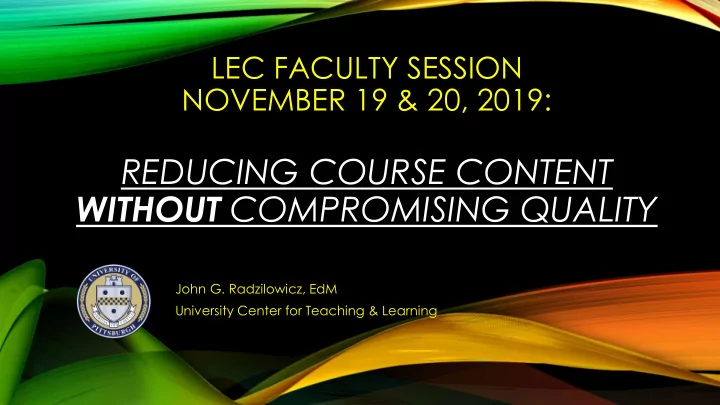

LEC FACULTY SESSION NOVEMBER 19 & 20, 2019: REDUCING COURSE CONTENT WITHOUT COMPROMISING QUALITY John G. Radzilowicz, EdM University Center for Teaching & Learning
OBJECTIVE: By the end of this session you will be able to… Explain and Apply the educational best practices for reducing course content while preserving course focus and quality.
You are trying to cover too much. Something will have to be cut!
I cannot cut anything!
Common Misconceptions About Course Content: • All of my content is essential! • The more content I cover, the more my students will learn. • Lack of student success is due to lack of effort. Cutting content rewards and pampers them.
THE RESEARCH IS CLEAR! “Coverage is the enemy of understanding”. ~Howard Gardner “ Dysfunctional illusions of rigor” must be abandoned. ~ Craig Nelson
Start cutting when you are planning your course. • Stop “content tyranny” – letting content topics drive your course plan. Avoid coverage that is a mile wide, but an inch deep. Students absorb less information and gain only a superficial understanding of material. • Begin by defining your learning objectives for the course. What do you want your students to learn in terms of both knowledge and skills? How will you assess their success? What learning activities will help develop this knowledge and skill set? • Make general content decisions based on your answers to these questions. If a content topic doesn’t directly support your learning objectives and plan – remove it!
INSTRUCTIONAL ALIGNMENT MODEL Assessment Learning Objectives Learner Learning Activities
Determine the essential content by focusing on teaching the analysis of issues or problems, rather than on simply conveying information. Mark each item as either “essential” or “helpful” with respect to student understanding. This is not a loss of rigor, but the gaining of focus. Use the following rules as a helpful guide to what is essential: • Focus on key ideas and general principles or themes. • Teach process and skills over information. • Include material not covered elsewhere. • Make room for clear examples and illustrations. • Include material of high interest/relevance/value to students. Remove every item marked “helpful”. Some of these items may be appropriate for readings or homework. Others will just have to go.
Know your students and adjust your content accordingly. • Be cognizant of your students’ level of familiarity with the course material, as well as their relative intellectual capabilities. • How can you best know your students? Ask questions and listen to what they say! Consider administering diagnostic tests or informal first-day surveys. These can be done at the start of the course, but also during the semester before beginning new content areas. Get instant feedback on your students' comprehension of a concept by using tools such as Top Hat. Keep students engaged by asking 1-3 questions. Then ask the class to respond to the collective results. Take time to evaluate and adjust your plan after EACH class.
Ask for help! • Share your experiences with colleagues and ask them for advice. • Consider making use of the resources of the Teaching Center. Consultants are available for individual or group consultations, syllabus reviews, and classroom observations. For more information, visit the Teaching Center website.
References: Ambrose, S.A., Bridges, M.W., DiPietro, M., Lovett, M.C., and Norman, M.K. (2010). How Learning Works. San Francisco, CA: Jossey-Bass. Antonelli, F. (2004). From applied to applause. Toronto Ontario Secondary Teachers’ Federation Journal , 2004, p. 38. Nelson, C.E. (2010). Dysfunctional illusions of rigor. In Nilson. L. and Miller, J. (Ed.), To Improve the Academy , 28, pp. 177-192. San Francisco, CA: Jossey-Bass.
Recommend
More recommend